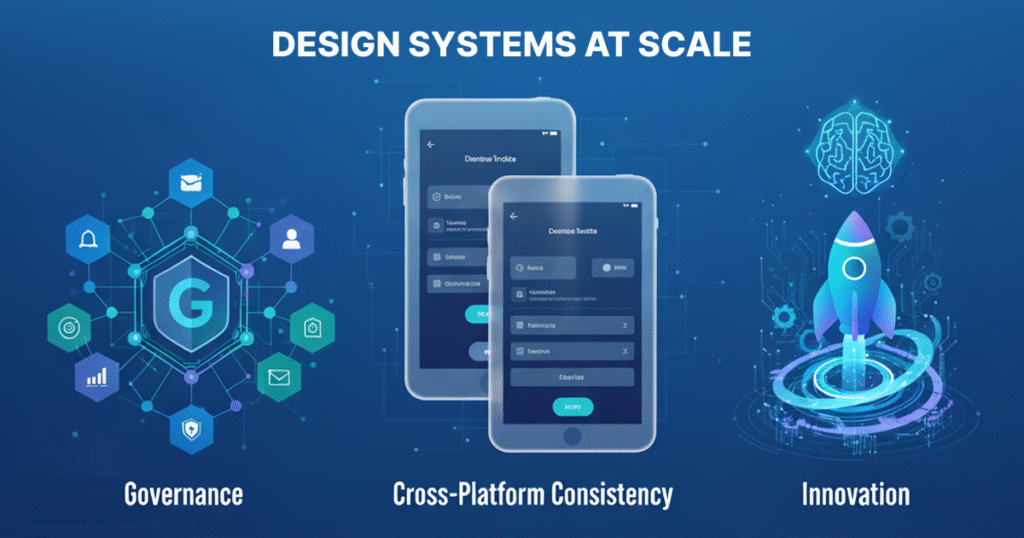In today’s digital landscape, Enterprise UX teams design for a world that spans mobile, web, desktop, and beyond. Users expect everything to feel consistent and connected, yet behind the scenes, most organizations struggle with fragmented design languages, duplicated effort, and inconsistent interfaces. The solution lies in Design Systems at Scale — frameworks that unify design, development, and governance to create seamless, scalable design ecosystems.
When executed thoughtfully, a design system becomes far more than a collection of components. It becomes a living product that fuels efficiency, promotes UI innovation, and aligns teams around a shared vision.

The Foundation: Cross-Platform Consistency
A robust design system starts with design tokens — the atomic variables that define color, typography, spacing, and motion. Tokens serve as the DNA of a brand, providing a single source of truth that enables cross-platform consistency.
However, consistency doesn’t mean everything must look identical. True harmony balances familiarity with platform-specific nuances:
Behavioral consistency – buttons, modals, and interactions behave predictably across devices.
Semantic consistency – shared labels and language reinforce clarity.
Task continuity – users can switch between devices effortlessly.
Platform sensitivity – iOS feels native, web feels web-like, yet both belong to the same brand family.
The art of scaling design systems lies in mastering this balance — enforcing sameness where it matters and allowing divergence where it enhances usability.
Governance: The Backbone of Scale
As organizations grow, governance becomes the guardrail that protects quality and coherence. In large-scale Enterprise UX, dozens of teams contribute to the same ecosystem. Without clear rules, a design system can quickly fragment.
Strong governance defines:
Roles and responsibilities – who owns, contributes, and approves changes.
Contribution workflows – how proposals, reviews, and merges are managed.
Versioning and deprecation – how components evolve and retire safely.
Audits and compliance – detecting drift or duplication before they spread.
Design–code synchronization – ensuring design files and code libraries stay aligned.
Different organizations use different governance models. Centralized models ensure tight control; federated systems allow product teams to contribute under guidelines; community-driven models encourage open collaboration. The golden rule: anyone can suggest improvements, but all changes follow process.
Governance isn’t bureaucracy — it’s the mechanism that allows speed without chaos. As Brad Frost notes, when governance fails, design systems dissolve into disconnected artifacts and lost trust.
Evolving Through Innovation
A great design system evolves with its products. Stagnant systems die quickly; adaptive ones scale naturally.
Bottom-Up Meets Top-Down
Many enterprises blend two complementary forces:
Bottom-up growth – components that emerge from product work get promoted to the shared library once validated.
Top-down direction – leadership sets architectural principles and brand guardrails.
This dynamic keeps creativity grounded in real needs while maintaining consistency at scale.
Metrics and Feedback
Effective systems rely on feedback loops. Track adoption rates, component usage, and drift. Collect insights from designers and developers. Some teams now use automation or AI to identify emerging patterns and propose new tokens, enabling continuous UI innovation.
Beyond Components
As maturity grows, design systems expand beyond UI parts into templates, layout grids, and complete experience frameworks. The focus shifts from visual uniformity to end-to-end Enterprise UX cohesion — from buttons to entire customer journeys.
Challenges and Solutions
Challenge | Solution |
Teams bypassing the system | Offer education, advocacy, and flexible extension paths. |
Tooling mismatch (Figma ↔ Code) | Invest in synchronization and automated pipelines. |
Governance fatigue | Keep review cycles lean and transparent. |
Legacy adoption | Gradual migration with wrappers and phased rollouts. |
Component drift | Schedule audits and enforce style linting. |
Scaling a design system isn’t purely technical — it’s cultural. Teams must feel ownership, not enforcement.
Case Study: Vodafone’s “Source”
Vodafone’s Source design system began as scattered UI fragments across products. Through well-defined governance, transparent contribution workflows, and regular audits, Vodafone aligned design and engineering under one ecosystem. The result was faster iteration, unified cross-platform consistency, and stronger brand coherence. Their journey proves that scaling design systems is as much about people as pixels.
Roadmap for Scalable Design
1. Start small: build tokens and 5–10 foundational components.
2. Establish governance early: even lightweight structure prevents drift later.
3. Measure continuously: monitor adoption, requests, and inconsistencies.
4. Automate synchronization: link design and code with real-time updates.
5. Encourage contribution: empower teams within defined guardrails.
6. Evolve deliberately: treat your design system as a product, not a project.
Conclusion
Design Systems at Scale blend governance, cross-platform consistency, and UI innovation into one continuous cycle of evolution. They transform fragmented enterprise design into a coherent, scalable design operation that grows with the organization.
Ultimately, success isn’t about creating more components — it’s about building shared understanding, collaboration, and consistency. When governance guides and creativity thrives, design systems become the foundation of modern Enterprise UX — unified, scalable, and endlessly adaptive.
Search
Categories

Author
-
Sivaraman is a front-end developer with 3 years of experience building clean, responsive web interfaces. He’s always curious about new technologies and enjoys putting ideas together from scratch—whether it’s a small feature or a full layout. When he gets stuck on a tricky bug, music is his go-to fix. With his favorite tracks playing, the solutions often start to click. Outside of coding, he’s a huge cricket fan—both watching and playing whenever he gets the chance. It’s his favorite way to relax, compete, and have some fun away from the screen.
